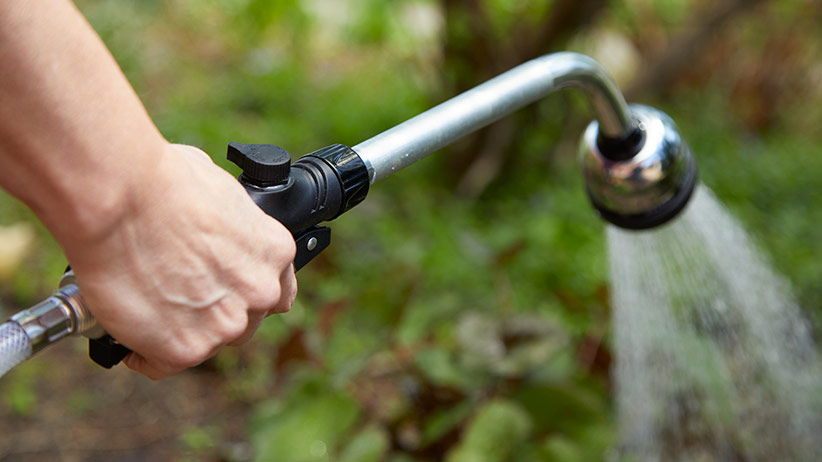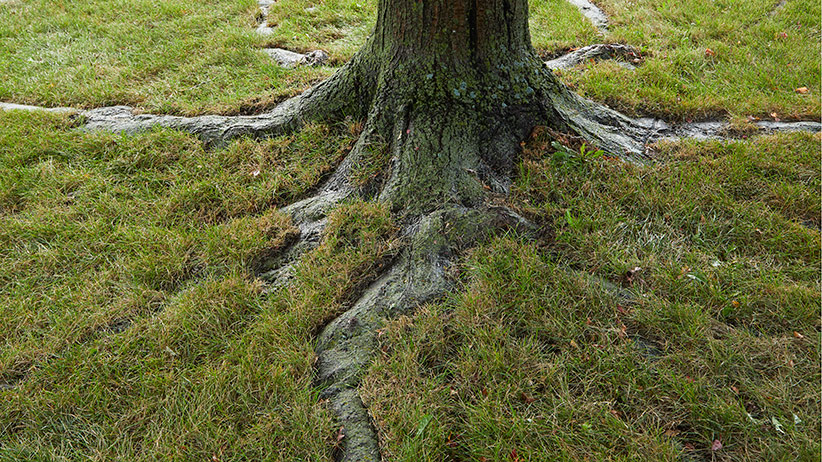Houseplant health crisis
Wouldn’t it be nice if our houseplants could tell us what is wrong? It’s easy to miss the signals a plant gives that let you know it is not happy, and sometimes those signals are ambiguous. When most gardeners see a wilting plant, they assume it needs more water. It might. But it also might be too wet. To prevent these things from happening, rather than watering on a rigid schedule, learn to read the situation before you water your houseplant.
What factors influence when you water houseplants?
In low light, plants need less water since they are growing less vigorously. And temperature can also affect houseplants in various ways. If the heat is on and the air is dry, your plant may need more water since it will transpire and lose moisture through its stomata, or pores. But once air-conditioning season is here, cut back on the water as cool, humid air will reduce the loss of moisture through the cells of the leaves.
How do I know if my houseplant needs water?
Here are three ways to tell if it’s time to water your houseplants:
1. Does it feel dry?
Check the soil surface before watering by sticking your finger into the potting mix — for most plants it should feel dry between the first and second knuckle, or the top inch of soil, and the potting soil will look light in color.
2. Does it feel heavy?
Lift the pot. The drier the plant, the lighter the soil. You’ll get a feel for how heavy a particular plant should be. Skip watering if it seems weighty and check again in a few days.
3. Does it look wet?
Check the drainage tray to make sure the plant isn’t standing in water more than a half hour after you water. I like to set a houseplant potted in a nursery container inside a decorative one with no drainage. This makes it easy to see if there’s any excess water and dump it.
You Might Also Like:
A Succulent and Cactus Watering Tip
How to Build a Terrarium
DIY Kokedama
How to Save Your Container Plants Over Winter
How to Repot an Orchid
Identifying underwatered and overwatered houseplants
Next, let me show you some common symptoms of under- and overwatering houseplants and how to fix them.
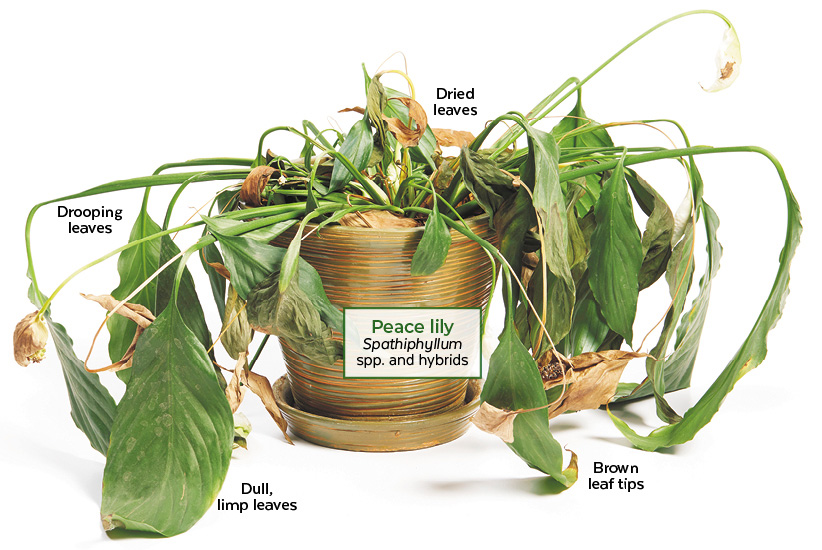
Signs of an underwatered houseplant
1. Drooping leaves
When a plant is too dry, its foliage becomes limp and will droop, starting with the leaves, then the whole stem. Some plants, like this peace lily (Spathiphyllum hybrid), will completely collapse when too dry.
2. Yellow or dried leaves
An underwatered plant wilts first, then some leaves turn yellow after it is rehydrated. They will often turn brown and dry or fall off soon after. Weeping figs (Ficus benjamina) are notorius for dropping yellow leaves if they dry out (but drop green leaves if the roots are too wet).
3. Dull or limp leaves
A plant in need of water often loses its glossy shine, turning dull or light in color and feel limp or wrinkly.
4. Brown leaf tips
Leaf tips may dry too much and turn brown when the plant is dehydrated. It is more prominent when a plant goes through multiple wilty-dry-then-moist cycles, especially in low-humidity conditions.
Will a houseplant recover from underwatering?
If a plant is wilting because it is too dry, it will rehydrate with a thorough watering, regaining its green color, shine and firm texture. If the soil is pulling away from the side of the pot, soak it for half an hour in a pan of water to completely saturate the root ball. If wilting occurs frequently, you may need to repot into the next size bigger container.
A dehydrated plant will recover, with some yellowing or loss of leaves. Yellowed leaves will not turn green again, so trim them off along with any dead leaves to tidy the plant up. Brown leaf tips can be carefully trimmed with scissors where the green color meets the brown to make it less unsightly.
Watering Products We Like:
3-in-1 Light/Moisture/pH Meter
2-Gal. Watering Can
Indoor watering can
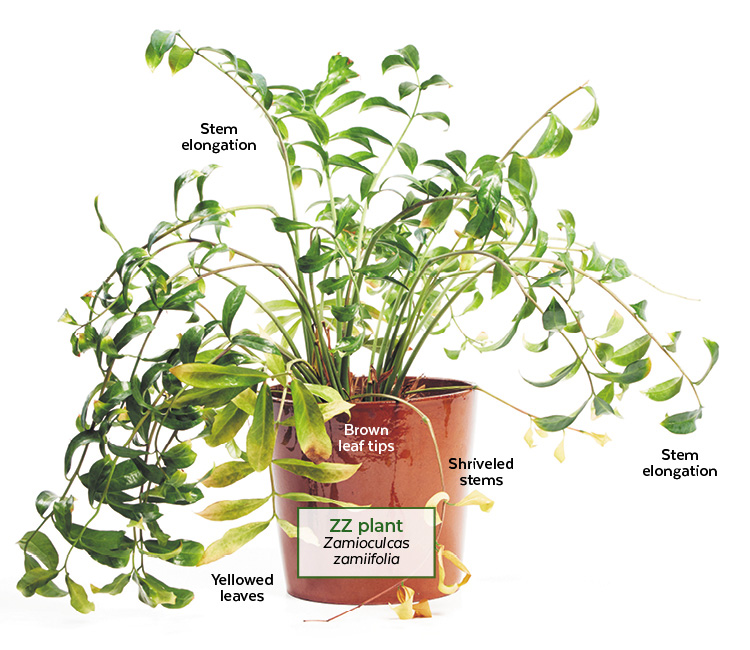
Signs of an overwatered houseplant
1. Brown leaf tips
Too much water means an excess of nutrients is in suspension at the roots, often causing the plant to absorb these nutrients whether it needs them or not. This excess can cause leaf tips and edges to burn. Dragon trees (Dracaena marginata) are especially prone to tip burn.
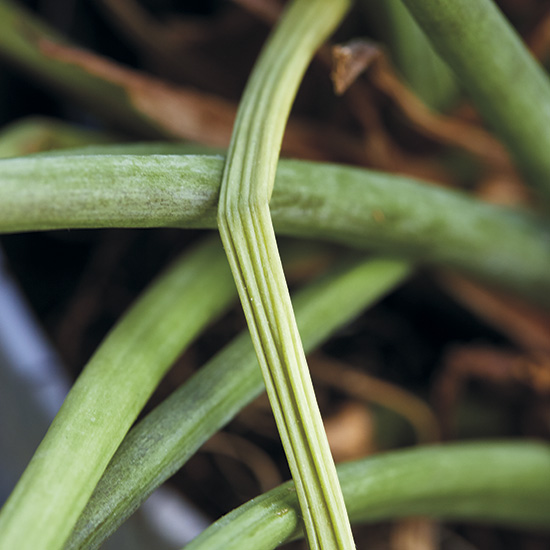
2. Shriveled stems
If roots are rotting, transport of water and nutrients is halted in the plant’s vascular system, and these “veins” may collapse, leaving shriveled stems.
3. Stem elongation
A plant without enough light can be easily overwatered since the plant uses less water with less vigorous growth. It will grow long and spindly, with more space between smaller-than-normal leaves and weak, floppy stems. This ZZ plant’s (Zamioculcas zamiifolia) stems would have dark green leaves spaced closer together on thick, upright stems if it had not been overwatered.
4. Yellowed leaves
Older leaves will turn yellow first when a plant is overwatered. They may be accompanied by blistered lesions, or oedema, where cells burst from having absorbed too much water. Yellowed leaves can also be caused by damaged roots that can’t absorb nutrients, leading to a deficiency. You'll see this often on rubber plant (Ficus elasticus), where its thick lower leaves turn yellow and fall off quickly when overwatered.
5. Root rot
If a plant stands in excess water it may have root rot. Confirm this by pulling the plant out of its pot and inspecting the roots — they’ll be brown or mushy. A plant with roots that are rotting away may have stems at the soil line that are mushy and black as well, and the plant may lean. Umbrella plants (Schefflera spp. & hybrids) respond to overwatering this way — they will have blackened stems when they have root rot, as well as limp new growth that droops at the leaf nodes.
Houseplant Products We Like:
Indoor Potting Mix
Leaf Shine
Micro Tip Pruners
Indoor plant care bundle
Planting Node Ceramic Containers
Will a houseplant recover from overwatering?
Overwatering is harder to cure than underwatering. Start by dumping excess water and drying the plant out. If the roots are rotted, it may be too late to save. But if some are still healthy, avoid watering until the soil is very dry. Poke holes into the soil with a pencil every few inches to help get air into the soil to the bottom of the root ball and try to dry it out. You may need to trim off the mushy roots and wash off water-logged soil before repotting into fresh potting soil.
Cut off yellowed or brown leaves and collapsed stems. Move it into more light if you can. After the plant begins recovering and sprouting new growth, cut back some of the leggier stems.









